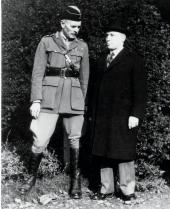
Andrew George Latta McNaughton was born on February 25, 1887, in Moosomin, North-West Territories. He earned his BSc (1910) and MSc (1912) degrees at McGill University. At the outbreak of World War I in 1914, McNaughton was given command of 4th Battery, Royal Canadian Artillery, Canadian Expeditionary Force. He distinguished himself with his scientific approach to gunnery, and by the end of the war, commanded the entire Canadian Corps artillery. After the war, he was appointed deputy chief of staff (1922-29), then chief of the general staff (1929-35), where he initiated the modernization of the Canadian militia. McNaughton then retired to civilian life. At the outbreak of World War II, McNaughton left his civilian job as president of the National Research Council (1935-39) to command the 1st Canadian Infantry Division, taking it overseas to Britain in 1939. By 1942, he had been promoted to command 1st Canadian Army. While overseas, he was responsible for instituting many scientific innovations to the army, including better aircraft ranging methods and antitank ammunition. McNaughton had endorsed the disastrous Dieppe operation of 1942; that, and other political difficulties including poor relationships with other Canadian and British politicians, brought on his resignation in December 1943. Returning to Canada, he served as Minister of National Defence (1944-45) in the Mackenzie King government. After the war, McNaughton was variously appointed president of the Atomic Energy Control Board of Canada (1946-48), Canada's Representative to the United Nations' Atomic Energy Commission and Permanent Representative to the United Nations (1948-49), and president of the Canadian Section of the International Joint Commission (1950-62). He died on July 11, 1966.
John Chaput
Print EntryHOME | BROWSE BY SUBJECT | ENTRY LIST (A-Z) | IMAGE INDEX | CONTRIBUTOR INDEX | ABOUT THE ENCYCLOPEDIA | SPONSORS TERMS OF USE | COPYRIGHT © 2006 CANADIAN PLAINS RESEARCH CENTER, UNIVERSITY OF REGINA | POWERED BY MERCURY CMS |
|||
| This web site was produced with financial assistance provided by Western Economic Diversification Canada and the Government of Saskatchewan. |
|||
 |
 |
 |
 |
| Ce site Web a été conçu grâce à l'aide financière de Diversification de l'économie de l'Ouest Canada et le gouvernement de la Saskatchewan. |
|||